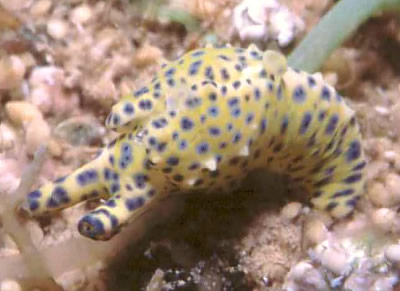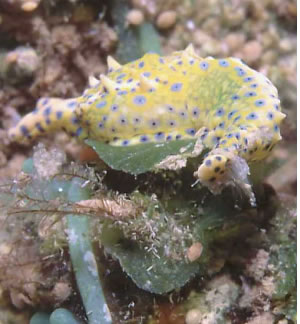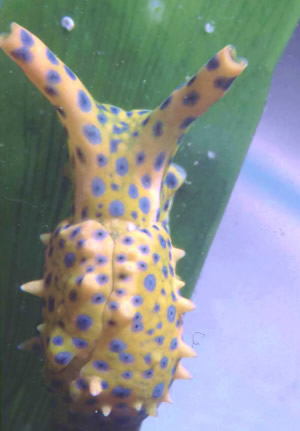Oxynoe viridis? from Turkey
May 16, 2002
From: Baki Yokes

Dear Bill,
Here are some photos of a species that we encountered recently. The blue spots indicate Oxynoe viridis, is it correct? If so, I think this is an other new record for the Mediterranean. We found 2 specimens on a Caulerpa racemosa field. It seemed that one of them was eating an alga other than Caulerpa. Do these animals have a broad range of food or was it only by chance, because the specimen did not leave the alga for a long time until we took it, and it was mowing back-and-forth on the alga as if it was trying to eat it. We observed that, beside C. racemosa, this species also likes C. prolifera and they do not specially prefer one of them when both are present. This species should also be tested to for its potential in controlling the Caulerpa invasion in the Mediterranean.
Upper Right: 29 April 2002, Antalya, Turkey
Divesite: Kucuk Ada, Uc Adalar. Depth: 6m, Size: 3cm. On Caulerpa racemosa.
Lower Left: As above - On an alga other than C. racemosa
Lower Right: 29 April 2002 - Aquarium photo on Caulerpa prolifera.
Best wishes
Baki Yokes
bakiyokes@turk.net


Dear Baki,
Although it is unusual to find an animal in the western Pacific so gaudily spotted with blue, specimens I used to find in Dar es Salaam, Tanzania were often this yellowish colour with prominent blue spots. So yes I agree with ypou that this is another lessepsian migrant from the Red Sea.
Concerning its diet, Oxynoe viridis seems to prefer Caulerpa racemosa in the field, but that may be because it is often the dominant species of Caulerpa in many of the localities Oxynoe is found. Obviously it will eat other species of Caulerpa and in Sydney, it is usually found on Caulerpa filiformis which is an introduced species, probably from South Africa. In southern Australia, O. viridis is usually found on Caulerpa cactoides. So it is possible the unknown algae in your lower right photo is being eaten by Oxynoe. Perhaps someone will recognise it for us.
This is another very interesting find.
Best wishes,
Bill Rudman
Related messages
-
Re: A juvenile Oxynoe viridis ? from nthn Mariana Islands
From: Takao Urasawa, July 28, 2008 -
Sea slug species from Turkey
From: Tom Turk, November 26, 2007 -
Re: Oxynoe viridis from East Timor
From: Brian Francisco, September 11, 2006 -
Oxynoe viridis from East Timor
From: Brian Francisco, September 9, 2006 -
Oxynoe from the Red Sea
From: Dr. Jacob Dafni, February 23, 2005 -
Egg mass of Oxynoe viridis
From: Nishina Masayoshi, July 6, 2002 -
Retractile papillae in Oxynoe
From: Nishina Masayoshi, May 10, 2002 -
Oxynoe? from Japan
From: Nishina Masayoshi, April 30, 2002 -
Oxynoe viridis from Hachijo Island, Japan
From: Nishina Masayoshi, August 17, 2001 -
Oxynoe viridis f rom South Australia
From: Nigel Holmes, August 17, 2001 -
Oxynoe viridis from Heron Island
From: Julie Marshall, August 6, 2000 -
Is this a Juliidae?
From: Grey McNeil, July 21, 1999 -
Oxynoe viridis & Lobiger viridis the same?
From: Karen Gowlett-Holmes, July 13, 1999
